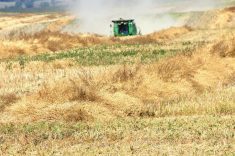Health Canada should take more seriously the potential risk of pesticide residue accumulation in humans, says a leading Canadian environmentalist.
Andrea Peart, director for health and environment with the Sierra Club of Canada, said in a May 17 interview there is growing evidence of higher-than-acceptable levels of pesticide residue in bodies of people exposed to the chemicals used in agriculture, on lawns and golf courses.
“We’re asking Health Canada to recognize the potential of this problem and to perform a national body burden test of Canadians to see if we have the same results in Canada that they have seen in the United States,” she said.
Read Also

Alberta researcher helps unlock the economics of farming
Lethbridge Polytechnic researcher helping agriculture producers with decision-making tools in economic feasibility
Peart was speaking after release of a report by the U.S.-based Pesticide Action Network on a survey of 9,282 Americans by the U.S. Centers for Disease Control. CDC found pesticides and their breakdown products in all of the people they tested, said the report. The highest levels of residue concentration were in women, children and Mexican Americans, who often work as farm labourers.
Peart said one of the flaws in the present regulatory system is that the Pest Management Regulatory Agency calculates acceptable risk based on exposure to one chemical at a time.
“In the real world, we are exposed to multiple chemicals simultaneously,” she said.
It was the second major assault on the safety of pesticides in a month. In late April, the Ontario College of Family Physicians issued a report that warned of the dangers to human health of exposure to pesticides.
Last week, the industry fought back by suggesting the analysis used to support the criticisms is incomplete and proper chemical use is safe.














